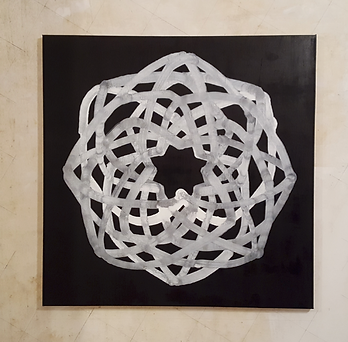Marie Cloquet
TRAVELING LIGHT
08/09/2019 - 20/10/2019
Marc Rossignol
Synchrone
Opening Sunday 9 September 2018
Marc Rossignol
Synchrone
Opening Sunday 9 September 2018
Marc Rossignol
Synchrone
Opening Sunday 9 September 2018
Marc Rossignol
Synchrone
Opening Sunday 9 September 2018
Herman Van Ingelgem
Foreign Bodies & Protheses
06/09/2021 - 17/10/2021






The Poetry of Disobedience
Lise Duclaux carefully follows life in her own garden: a communal urban garden, surrounded by several blocks of flats in the north of Brussels. She observes the plants and flowers—and more recently also the bees— that grow and reside there, with none or little human interference. She translates her observations into detailed pencil drawings that visualize the interaction of flowers and bees: bees landing on a flower in search of nectar, or sleeping in it.
Though the attractive drawings are quite naturalistic—and their true-to-nature character is enhanced by, for example, a reference to their scale in the margin of the drawing—they serve no scientific purpose. For Duclaux, her drawings are essentially about demonstrating poetic beauty and the appreciation of a non-human, minuscule, authentic life that is usually ignored by us, the viewers. The images relate closely to a series of riso prints of text fragments. The sentences or phrases find their origin in her own notes or thoughts, sometimes in scientific or philosophical treatises. However, in their aesthetic transformation they flirt with the visual language of protest posters and slogans. Duclaux invariably uses the Univers font, which harmonizes particularly well with her world view.
Duclaux treats plants and animals as equals and renders visible their autonomy, resilience and desire. In the past, she has also worked with ‘weeds’ (what turns a plant that decides to grow into something ‘unwanted’?) and moles (as humans, we mainly see the animal’s imperfections, whereas as a solitary explorer it creates ingenious systems of tunnels and skilfully digs up qualitative earth from the depths). So-called wild flowers and wild bees choose for themselves where they grow and where they dwell; like humans, they seek a way of life that is the most satisfactory to them. But in our eyes, they are often unneeded or even a nuisance. In fact, that is only so from a perspective that focuses on a link between production and aesthetics—according to the prevailing human (Western) standard, some of these organisms are ugly or useless, and therefore unwanted. Duclaux obstinately turns her gaze towards the organisms that from a production-oriented and utilitarian perspective are the least useful—and asks the question: for whom?
In fact, scientific discourse uses an economic language—with terms such as ‘costs’, ‘benefits’, ‘profit’ and ‘loss’—and ‘wild’ bees are referred to as ‘disobedient’ and ‘rebellious’. They don’t produce honey, and even worse, they feed on the nectar of flowers, but they don’t necessarily play a role in pollinating flowers. In other words, they are considered rebels or cheaters, thieves of nectar, because they seek what they need, but sometimes don’t give anything back. Arrêtons de regarder le monde à la lorgnette de la production, is one of the statements we read in the riso prints. Not all in the reality that surrounds us focuses on some sort of profitable production; we therefore shouldn’t describe it as such.
Calling someone a cheater implies that there are rules. Why do we humans think that we can decide what those rules are? If the bees in Duclaux’s garden are cheats because they only take and give nothing back, aren’t humans the biggest cheats of all? Isn’t it the case that the rebellious, disobedient, indomitable plants and animals bear witness to a tremendous resilience that questions established, enforced values? Can the behaviour of the ‘rebellious’ bees serve as a critical microscope to scrutinize our scientific language? Can it be a mirror for human society? On est où là? another print asks. Where are we then? Isn’t it time to look around, to look beyond human society and the limited perspective of our knowledge? In 2016, the Australian philosopher Glenn Albrecht introduced the term Symbiocene as a potential alternative to the Anthropocene: the current geological era, in which humans obviously have a huge and pernicious impact on the planet. What underlies the Symbiocene is the idea of symbiosis (the living together of several organisms) and the fact that all life is interlinked through invisible nurturing networks of mycelia and mycorrhizae.
Unpretentiously, Duclaux promotes a horizontal, non-hierarchical way of thinking, and a greater symbiosis between humans and other life forms. One of her statements reads: La nature n’existe pas. Nature is not a separate world, isolated from human society—we are part of nature and we exist in an interdependent (indirect or symbiotic) relationship with all that surrounds us.
What if humans weren’t the measure of all things? Isn’t it the case that nature—life and the environment—defines us instead of the other way around? The control humans seek over life by naming, studying and manipulating processes and organisms, is mostly an illusion. That is what ‘wild’ (meaning: beyond our control, spontaneous, disobedient, resilient) plant and animals make clear to us. A recent article in the magazine EOS discussed how in an urban setting, some birds, such as magpies and crows, build their nest with materials that are intended to scare them off. ‘Rebellious magpies and crows mock this urge to shoo them: they even build nests with anti-bird pins,’ the article states.
Disobedience can also be a deliberate action to bring about change, as several citizens’ movements have shown (for example, the participants in the climate protests who skip school). Can we, as human society, learn something from this combative resilience? Can we gather new insights to adapt to an organically evolving environment, to grow into a better way of being—like the wild flowers and bees in Duclaux’s drawings—when obsolete rules seem to discourage us?
Tamara Beheydt, July 2023
Translated by Dirk Verbiest
.png)
.png)

